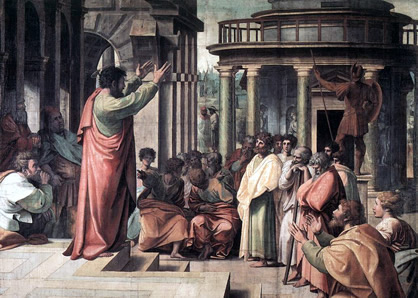T
-T-
Tabernacle
Means "dwelling place." It was a special tent where the
Israelites worshiped God. It is sometimes called the Tent of
Meeting. It was the place where God would meet his people.
Tabernacles (Festival, sanctuary, Succoth)
The seventh yearly feast (Lev. 23) when all males were required
to come to Jerusalem. The people celebrated Israels wandering
in the desert by living in temporary shelters. Included a water
ceremony as part of prayer of rain.
Table of showbread
Table that stood in the holy place of the tabernacle and temple,
outside the Holy of Holies. Priests placed the bread of the
Presence (Ex. 25:30), or showbread, on it. The bread symbolized
the Israelites commitment to give the Lord the results of their
work. It also testified that everything they received was a gift
from God.
Talmid
The Hebrew word for disciple is talmid. This word stresses the
relationship between rabbi (teacher or master) and disciple
(student). A talmid of Jesus' day would give up his entire life
in order to be with his teacher. The disciple didn't only seek
to know what the teacher knew, as is usually the case today. It
was not enough just to know what the rabbi said, but the
foremost goal of any talmid was to become like the rabbi and do
what the rabbi did.
Tekton
A craftsman who often worked with stone. Jesus was trained as a
tekton while growing up in nearby Nazareth.
Tel
Large mound or hill composed of layers of debris from several
different periods of settlement.
Temenous
Sacred building.
Temple
A building where people worship divine beings. God told Israel
to build him a temple and worship him there. God showed his
people that he was with them by having his presence in the
temple. In the New Testament, we learn that the new temple is
not a building. God's people are now the temple of God. God's
Spirit lives within them.
Temple Mount
The ridge on which Jerusalem's Temple was built and/or the
platform on which the Temple and its courts stood. King Herod's
platform was supported by massive walls, the tallest standing
160 feet, and measured more than 1,500 feet long, north to
south, and more than 900 feet wide, east to west. It
accommodated 200,000 pilgrims.
Tepidarium
Warm room in Roman baths.
Tetrarch
A Roman political office; meant one-fourth of a kingdom. When
Herod died, his three sons and others received parts of his
kingdom; two sons become tetrarchs, one an ethnarch.
Tfillin
Small boxes and the accompanying leather straps worn by
observant Jews during prayer. The boxes are placed on the
forehead and near the heart and bound in place by the leather
straps. (See Deut. 6.)
Thomas
Most Christians remember Thomas as the doubting disciple who
didn't believe the other disciples when they told him they'd
seen the risen Jesus (John 20:1925), and who said that he'd
only believe if he touched Jesus' sacred hands and side (John
20:25). But Thomas was also the disciple who demonstrated great
faith and dedication to Jesus during his walk to Jerusalem. When
Jesus told his disciples that they were returning to Judea, they
protested, recalling that the Jews had tried to stone him there.
But Thomas courageously agreed with Jesus, saying, "Let us also
go, that we may die with him" (John 11:16). And the disciples
remained with Jesus and headed toward Jerusalem.
Tiberias
Capital built by Herod Antipas on the Sea of Galilee's western
shore; named for Tiberias Caesar. Believed to be built over a
cemetery and considered unclean by religious Jews. After AD 70,
it became a center of Jewish religious thought.
Tithe
Means "a tenth." In the Old Testament, God's people would give a
tenth of their crops or animals to God. This was a sign that God
owned the land and had blessed his people. Also, the tithe would
be used to support the priests and Levites, and to help the
poor.
Topheth
Place where the Israelites sacrificed their children. Based on a
Hebrew word meaning furnace or fireplace, the word was
altered by Hebrew scribes to mean shameful thing. It came to
apply as well to the cemetery where the victims remains were
buried and to the location in the Hinnom valley where the
sacrifice occurred.
Torah
Hebrew word meaning teaching or instruction. It refers to
the first five books of Moses.
Triclinium
A reception or banquet hall or dining room. The tables were
placed in a U-shape and surrounded by couches, where diners
reclined as they ate.
Tufa
Volcanic ash that becomes a soft stone.
Tumuli
Burial mound.
Tyropean Valley
This valley lay between Davids City and the Western Hill where
the Upper City was located. Hezekiah expanded the city into this
valley. The Western Wall of Herods Gentile Court was located
here, as was the Pool of Siloam where Jesus sent a blind man to
wash.
Tzitzit
Tassels. In Numbers 15:3839, God commands the Israelites to
wear tassels on their garments as a reminder to them to obey all
the commandments. In practice, each tassels came to have five
knots (representing Torah), four spaces between the knots
(representing the name YHWHYaHWeH). The numerical value of the
word tzitzit (600), plus the five knots added to the eight
strands of thread in each knot added up to the number 613a
number of commandments God gave in the Torah.


